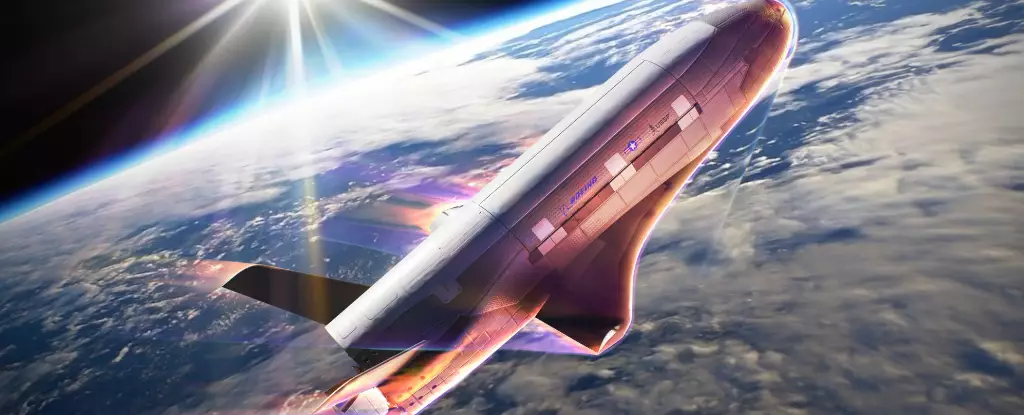Since its first launch in 2011, the X-37B Orbital Test Vehicle (OTV) has captivated aerospace enthusiasts and experts alike with its unique design and mysterious purpose. Developed by Boeing and currently operated by the US Space Force (USSF), the X-37B is a pioneering spacecraft crafted for low-earth orbit missions, an operational range that extends from 240 to 800 kilometers (150 to 500 miles) above the Earth’s surface. Its primary role revolves around testing innovative technology for reusable space vehicles, thereby contributing to the future of space exploration and national defense.
On December 29, 2023, the X-37B initiated its seventh mission, dubbed OTV-7. This mission appears to be particularly ambitious, as it tackles experiments aimed at elucidating the effects of space radiation and advancing Space Domain Awareness (SDA). Recently, the vehicle has been rumored to engage in a series of sophisticated orbital maneuvers, aimed specifically at enhancing its stealth capabilities.
Among these maneuvers stands out a technique known as “aerobraking,” which involves the spacecraft making incremental contacts with the upper layers of Earth’s atmosphere. By shedding speed and gradually lowering its orbit without significantly consuming fuel, the X-37B executes a level of operational ingenuity that speaks to decades of extensive space research. The USSF has revealed that this technique draws on not only the success of the X-37B’s previous missions but also hard-earned lessons from prior space explorations, such as those conducted during missions to Mars.
Aerobraking is not a new concept in space operations; it was previously utilized by various missions, including the Mars Global Surveyor in 1997 and the Mars Reconnaissance Orbiter in 2006, among others. However, OTV-7 marks the first occasion where the X-37B will deploy such a maneuver. This innovative approach not only displays the vehicle’s adaptability but also highlights the significance of advanced maneuverability in modern space missions. As stated by Secretary of the Air Force Frank Kendall, these developments showcase the USSF’s commitment to cutting-edge innovations in the pursuit of national security.
The potential ramifications of this heightened maneuverability are significant. By executing unpredictable orbits that can effectively baffle detection systems, the X-37B enhances the United States’ strategic advantages in space. Chief of Space Operations Gen. Chance Saltzman emphasized the milestone this maneuver represents, suggesting that it opens new avenues for operational capabilities and strategic missions in an increasingly competitive and complex space environment.
Despite its advanced capabilities, the specifics of the X-37B’s missions remain largely classified, fuelling speculation and intrigue. During the 2019 Aspen Security Forum, former USAF Secretary Heather Wilson elucidated some of the vehicle’s potential advantages. According to her, the X-37B adopts orbital patterns that resemble an egg shape, allowing it to execute close passes to Earth while remaining elusive to adversaries’ tracking systems. This degree of stealth undoubtedly complicates surveillance efforts, as indicated by her remarks on how this uncertainty can frustrate global competitors.
Astrophysicist Jonathan McDowell noted that this capability serves to distort tracking predictions, introducing an element of unpredictability. For adversaries relying on established orbital forecasts, such disturbances necessitate ongoing recalibrations to pinpoint the X-37B’s next maneuvers, which could create significant operational challenges.
As the X-37B successfully completes its aerobraking operations and transitions to subsequent phases of the OTV-7 mission, a suite of planned experiments is set to proceed. These tests will explore multiple facets of operations in novel orbital regimes and delve into the effects of space radiation on biological samples. One particularly intriguing experiment, dubbed “Seeds-2,” involves studying the impact of radiation on various plant seed strains provided by NASA. The emphasis on mitigating space debris through responsible de-economic practices will also be a focus, with some of the spacecraft’s components set to be ejected in alignment with established standards.
The X-37B represents a pivotal shift in understanding and shaping aerospace operations. Through its innovative designs and strategic maneuvers, it epitomizes what modern technology can achieve in the realm of space exploration and national defense. As the world becomes increasingly aware of the importance of capabilities beyond our atmosphere, the role of the X-37B is bound to resonate far beyond its current operations. The vehicle serves as not just a testament to American ingenuity but also as a harbinger of an era marked by heightened competition and exploration in the cosmos.


Leave a Reply